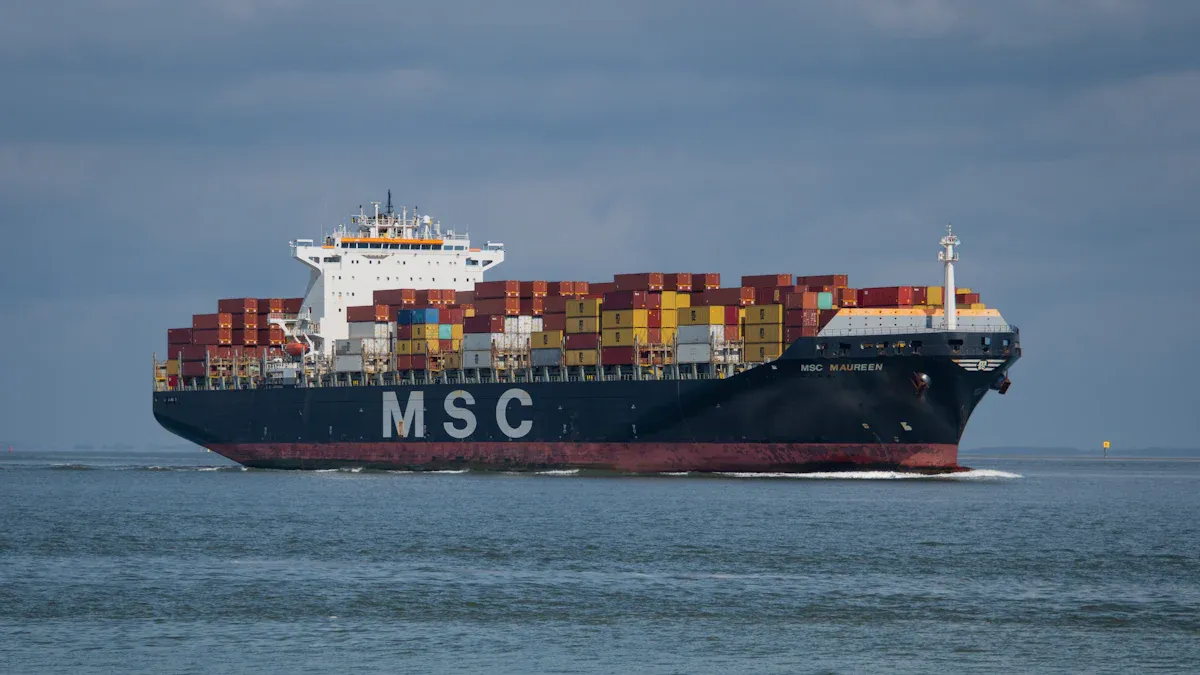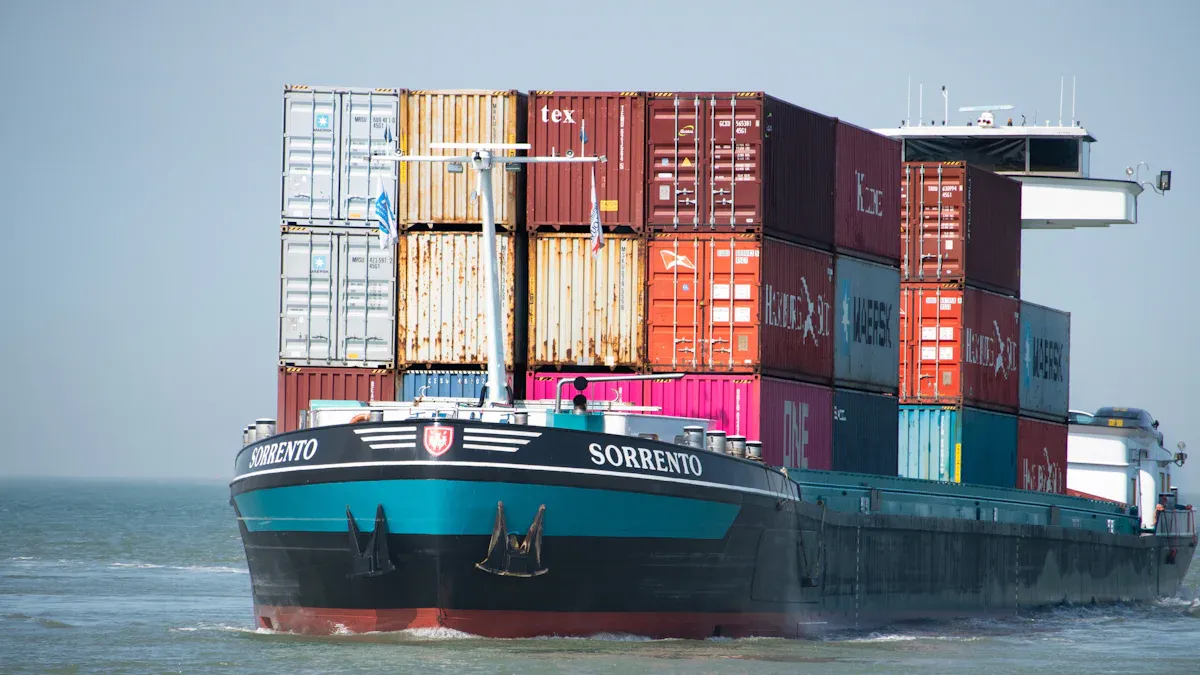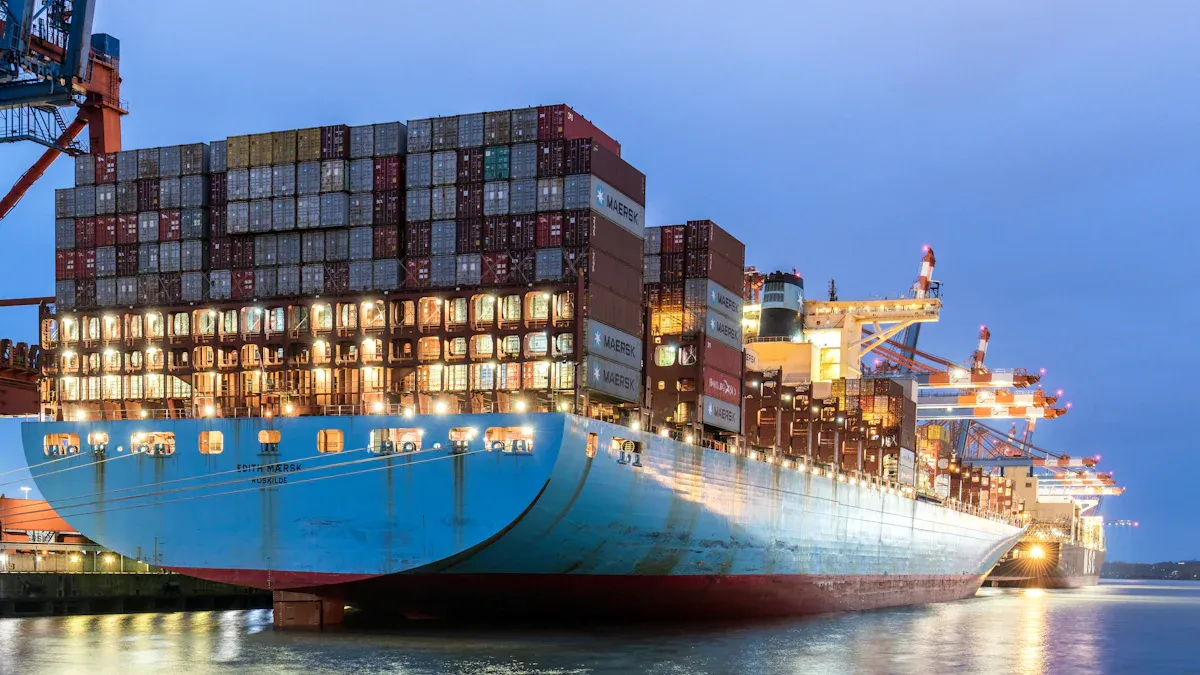How Ocean Shipping Powers Global Trade in 2025

Ocean shipping helps global trade by moving goods quickly worldwide. In 2025, new technology has changed how shipping works. Companies use smart tools and data to lower costs by 15%. They also make services better by 65% with these tools. These changes cut inventory by 35%, making shipping greener and cheaper.
High costs and slow use of cleaner fuels are still problems. But energy-saving tech is improving how ships work.
Key Takeaways
Ocean shipping is very important for global trade. It moves over 80% of goods worldwide quickly and cheaply.
New shipping technologies can lower costs by 15%. They also improve service quality by 65%, making it better for businesses.
Using ocean shipping is better for the environment. It creates fewer greenhouse gases than other transport options.
Understanding Ocean Shipping and Its Role in Global Trade
What Is Ocean Shipping?
Ocean shipping means moving goods across oceans. It is very important for global trade. Businesses use it to send large amounts of products cheaply and quickly. This type of transport has been used for hundreds of years. It started with old trade routes and now uses modern shipping containers. Today, over 80% of the world's trade happens through ocean shipping. It connects countries and helps meet what people need.
Ocean shipping has many benefits. It costs less than air shipping, especially for heavy or big items. Special containers, called reefers, keep food and medicine fresh during transport. Because of this, ocean shipping is a top choice for businesses trading worldwide.
Key Components of Ocean Shipping
Ocean shipping works well because of several important parts. These include checking risks, managing money, and following global rules. For example, companies watch the weather and politics to avoid problems. They also track costs and profits to save money.
Technology helps a lot too. Tools like data prediction and route planning save fuel and time. Ports are chosen based on how fast they load and unload ships. All these parts make ocean shipping reliable and efficient, which is why it’s so important for global trade.
Key Component | Description |
|---|---|
Watching weather and politics to avoid shipping problems. | |
Predictive Analytics | Using data to plan better and save resources. |
Port Performance Metrics | Checking how fast ports handle ships to pick the best ones. |
Types of Cargo in Ocean Freight Services
Ocean shipping moves many kinds of goods, each needing special care. The most common is container shipping, which carries items like clothes, electronics, and furniture. Bulk shipping is for loose items like coal or grain, loaded directly into the ship.
Some goods need special handling. Reefers keep food and medicine at the right temperature. Tanker ships carry liquids like oil and chemicals. Big items, like machines, need special tools to load and unload. Dangerous goods, like chemicals, must follow strict safety rules. These different types of cargo show how flexible ocean shipping is for global trade.
Cargo Type | Description |
|---|---|
Keep food and medicine fresh during shipping. | |
Hazardous Material Shipping | Moves dangerous goods safely by following strict rules. |
Oversized Cargo Transport | Handles big items like machines with special tools. |
Container Shipping | Carries many goods in standard-sized containers. |
Bulk Shipping | Moves loose items like coal or grain directly in the ship. |
Tanker Shipping | Transports liquids like oil and chemicals in special ships. |
The Importance of Ocean Shipping in Global Trade
Cost-Effectiveness and Large-Scale Capacity
Ocean shipping is one of the cheapest ways to move goods. It can carry a lot of cargo for much less money than other transport methods. For example, sending a container 4,355 miles by sea costs about $3,500. But moving the same container 2,000 miles by train costs $5,500. This low cost helps businesses keep prices low and earn more profits.
Ocean shipping also meets many market needs. It moves bulk items like grain and keeps fresh food safe. Its large capacity helps businesses meet global demand easily. This ability makes ocean shipping a key part of global trade. It helps companies grow and succeed in international markets.
Connecting Global Economies Through Ocean Freight Services
Ocean shipping connects countries and their economies. It moves goods to places where they are needed most. Ports are important in this system, handling millions of containers every year. But problems like crowded ports can slow down trade. Improving ports and building better facilities can help handle more trade and keep economies stable.
By linking producers and buyers worldwide, ocean shipping boosts economic growth. Countries can focus on making what they are best at and trade for other goods. This creates a balanced and connected global economy.
Environmental Benefits of Ocean Shipping
Ocean shipping is cheap and better for the environment. Ships release fewer greenhouse gases than planes or trucks. This makes ocean shipping a greener choice for businesses wanting to help the planet.
The shipping industry is also using cleaner fuels and better technology. These changes lower pollution even more, making ocean shipping an eco-friendly option. By choosing ocean freight, you help the environment while trading globally.
Innovations Shaping Ocean Shipping in 2025

Automation and Smart Shipping Technologies
Automation is changing how ocean shipping works today. Ports now use smart tools like IoT and self-driving systems. These tools make work faster and more organized. For example, smart ports load and unload ships quickly. This saves time and lowers costs.
Companies using digital tools cut costs by 15%, reduce inventory by 35%, and improve services by 65%.
AI and big data are also very helpful. They guess demand and plan better routes to save fuel. Tools like AR and VR improve training and ship checks. This makes shipping safer and more reliable. These new ideas make ocean shipping faster and smarter.
Digital Tracking and JusTrade’s Role in Supply Chain Transparency
Digital tracking has changed how we follow shipments. You can now see where your goods are at any time. JusTrade, a customs expert, helps make this process clear. Their platform uses AI and big data for smooth tracking and customs work.
Key Benefit | Description |
|---|---|
See where goods are and get updates on delays. | |
Faster Operations | Plan routes better and save time, cutting costs. |
Improved Customer Trust | Share real-time updates to keep customers happy. |
Smarter Decisions | Use data to make better choices for smoother shipping. |
Lower Costs | Avoid delays and save fuel with smarter planning. |
JusTrade’s tools help goods move through customs faster. This reduces delays and makes shipping more efficient.
Sustainability Initiatives in Ocean Freight Services
Ocean shipping is a greener way to move goods. Ships pollute less than planes or trucks. The industry now uses cleaner fuels and energy-saving tools to cut pollution even more.
Metric | Description |
|---|---|
GHG Reporting | |
Emission Reduction | Cut harmful gases like black carbon and NOx to clean the air. |
Data Tracking | Use tools to measure and compare freight activity. |
Better Planning | Use data to plan for a greener future. |
Cleaner tech and smarter routes save fuel and cut pollution. Choosing ocean shipping helps the planet and keeps trade affordable.
Challenges and Opportunities in Ocean Shipping

Economic and Geopolitical Challenges
Ocean shipping faces big money and political problems. High shipping costs and crowded ports cause delays and extra expenses. Not enough workers, worsened by Covid-19, make ships wait longer. This uses more fuel and adds pollution. Experts say crowded ports cost $18 billion more in fuel each year.
Political issues make shipping harder too. Fights near key waterways, like the Suez Canal, mess up trade routes. Low water in the Panama Canal and conflicts, like Houthi attacks, force ships to take longer paths. These problems slow down shipping and make trade less certain for businesses.
Environmental Rules and Compliance
New rules are changing how ships work to cut pollution. Governments now demand cleaner fuels and greener practices. For example, the Clean Shipping Act of 2022 pushes for zero-pollution fuels by 2040. The Mediterranean Sea Emission Control Area limits harmful gases like sulfur.
Following these rules costs a lot of money. Programs like the Diesel Emissions Reduction Act help companies pay for cleaner ships. California’s At-Berth Regulation makes docked ships control emissions or face fines. These rules push for cleaner shipping but need careful planning and spending.
Rule/Program | What It Does |
|---|---|
Clean Shipping Act of 2022 | Aims for zero-pollution fuels by setting carbon standards. |
California’s At-Berth Regulation | Forces docked ships to cut emissions or pay penalties. |
Innovation Opportunities with JUSDA’s Help
Even with problems, ocean shipping has room for new ideas. JUSDA’s smart tools help fix shipping issues. Using AI and big data, JUSDA cuts costs by 15% and improves services by 65%. Their tools make customs faster, plan better routes, and improve tracking.
Technology is key to better shipping. JUSDA’s JusTrade platform makes customs easier and reduces delays. Maritime analytics uses data to make smarter choices. These tools make shipping faster, greener, and more dependable for global trade.
Innovation Type | What It Does |
|---|---|
Makes shipping smoother and helps with better decisions. | |
Maritime Analytics | Uses data to improve shipping and lower risks. |
JUSDA’s tools help solve shipping problems while supporting green and smart solutions.

JUSDA Solutions
To provide you with professional solutions and quotations.
Ocean shipping keeps global trade strong by linking markets. It helps economies grow and stay connected. Higher freight rates, shown in the Shanghai Freight Index, prove its value. New ideas like tracking tools and eco-friendly methods improve shipping. These changes ensure ocean freight stays important for trade worldwide.
